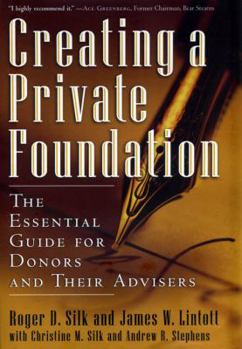Creating a Private Foundation: The Essential Guide for Donors and Their Advisers
Select Format
Select Condition 
Book Overview
Imagine all you'd like to accomplish with your philanthropy. Now picture a large portion of your resources never reaching their intended use due to poor strategies, mismanagement, or unnecessary taxes. Today the opportunities in the philanthropic sector are greater and more varied than ever. Private foundations, which offer several estate and tax-planning advantages as well as unparalleled donor control, have become the vehicle of choice for more than sixty thousand individuals and families--and may be ideal for you. Creating a Private Foundation introduces the issues you need to understand and gives the big picture on how foundations work. It tells you exactly what is involved for you, for the causes you care about, for your finances and taxes, and for your heirs. Chapters address the practicalities as well as the implications of founding, funding, organizing, and operating an effective foundation, including growing its endowment, allocating its assets, and selecting professional foundation management help. Roger Silk, James Lintott, and their colleagues, leaders in the foundation consulting arena, have pooled their wisdom in this comprehensive guide for donors and your advisers. If you're looking to make a difference, there is no better guide.
Format:Hardcover
Language:English
ISBN:1576601366
ISBN13:9781576601365
Release Date:July 2003
Publisher:Bloomberg Press
Length:203 Pages
Weight:1.25 lbs.
Dimensions:0.8" x 6.4" x 9.7"
Customer Reviews
4 ratings
Business Dealing
Published by Thriftbooks.com User , 16 years ago
Excellent job, delivered prior to expected delivery date. In condition stated. Would definitely utilize again
private foundation fundamentals
Published by Thriftbooks.com User , 18 years ago
The book is more for donors than advisors. I does not provide enough of the necessary essential legally technical information.
Useful Primer
Published by Thriftbooks.com User , 21 years ago
Unwitting new philantrophists sometimes end up with bureaucratic creatures that do exactly what the donor did not want. This book is full of practical advice on how to avoid unpleasant surprises if you set up a foundation of your own, such as finding out that you have no control over its activities. It also gives a succinct review of investment problems. Foundations can potentially last for many generations. But they can easily mismanage themselves into oblivion in short order. The authors identify seven deadly investment sins. For example, foundations don't need to frequently redeem their investments, but some mistakenly invest in liquid assets and lose returns as a result. They would be better off with non-traditional investments like private-equity, income producing real estate, hedge funds, and timber.Many foundations fail to diversify, unwittingly taking on risk. THey start with stock from the founder's company and continue to hold a concentrated position, exposing themselves to the vagaries of that business. In 2002 the David and Lucille Packard Foundation was forced to cut its donations drastically when Hewlett-Packard stock fell. IN short, an easy-to-read, useful guide.
Creating Private Foundation
Published by Thriftbooks.com User , 21 years ago
A great great book to give to your existing Private Foundation clients, as well as those considering their options. The book hits on several key points among many others - which are the reason to formalize your investment policy statement(IPS) and donor intent issues. The author is correct that too often good intentions fail to result in effective results. It deals with other vehicles like charitable lead trusts (CLTs) and charitable remainder trusts (CRTs) as well as donor advised and support organizations. It is a big picture book not a technical how to for the attorney!





